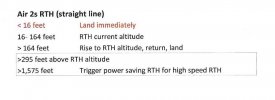- Joined
- Aug 22, 2017
- Messages
- 102
- Reactions
- 38
- Age
- 58
I’m not near my Mavic 3 Pro at the moment so I can’t confirm the answer to my question at the moment, but am curios to know If anyone knows.
And that is, I was flying this last weekend. I launched behind a house at the bottom of a hill. I flew up and over the top (which I’m thinking was a few hundred feet higher at least). I lost reception after going over the top. It then proceeded to do a RTH. It only took what seemed like a few seconds and I was able to see again and I cancelled and few it back.
I’m pretty sure I have it set to fly to 265 ish feet on the return to home. I don’t believe it’s set to the other option of fastest or most optimal way (I forget what that option is called). Given I was most likely much higher than 265 feet (but not too much higher than the trees at the top), isn’t the RTH supposed to “DECEND” to 265, which obviously would have caused a problem?
But I did have obstacle avoidance on, so maybe that bailed me out?
Just curios as I didn’t even think of this possible issue until a few days ago..
And that is, I was flying this last weekend. I launched behind a house at the bottom of a hill. I flew up and over the top (which I’m thinking was a few hundred feet higher at least). I lost reception after going over the top. It then proceeded to do a RTH. It only took what seemed like a few seconds and I was able to see again and I cancelled and few it back.
I’m pretty sure I have it set to fly to 265 ish feet on the return to home. I don’t believe it’s set to the other option of fastest or most optimal way (I forget what that option is called). Given I was most likely much higher than 265 feet (but not too much higher than the trees at the top), isn’t the RTH supposed to “DECEND” to 265, which obviously would have caused a problem?
But I did have obstacle avoidance on, so maybe that bailed me out?
Just curios as I didn’t even think of this possible issue until a few days ago..












